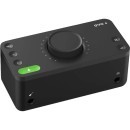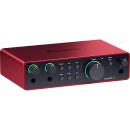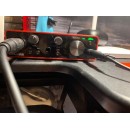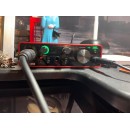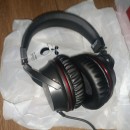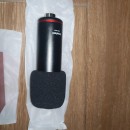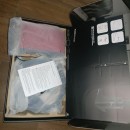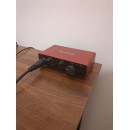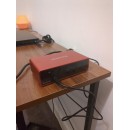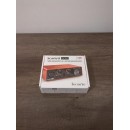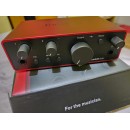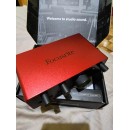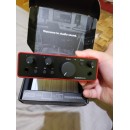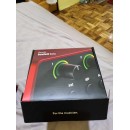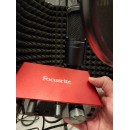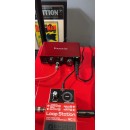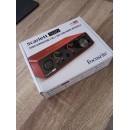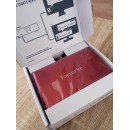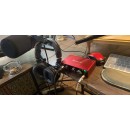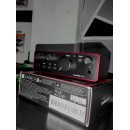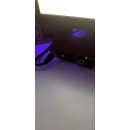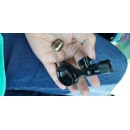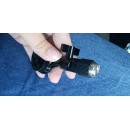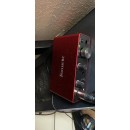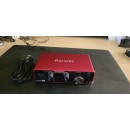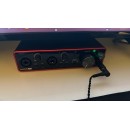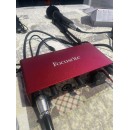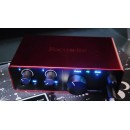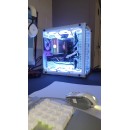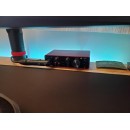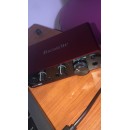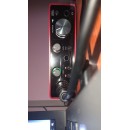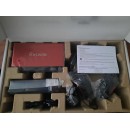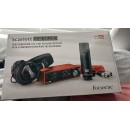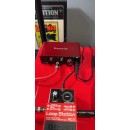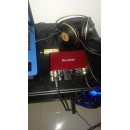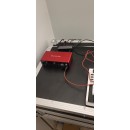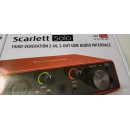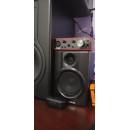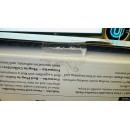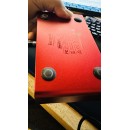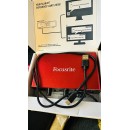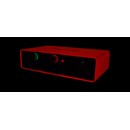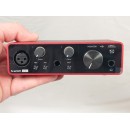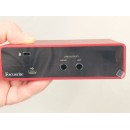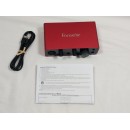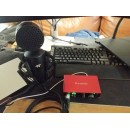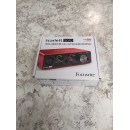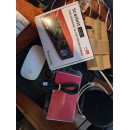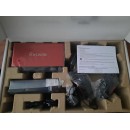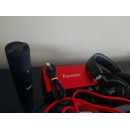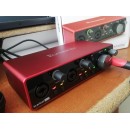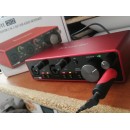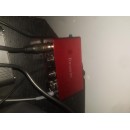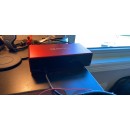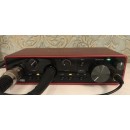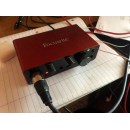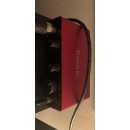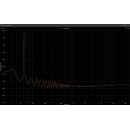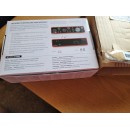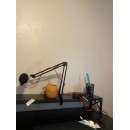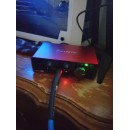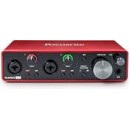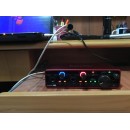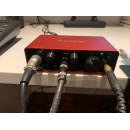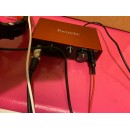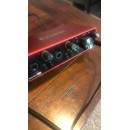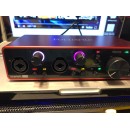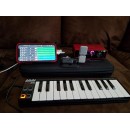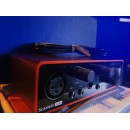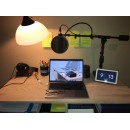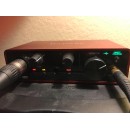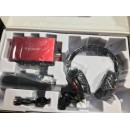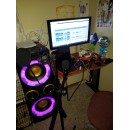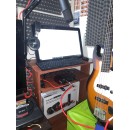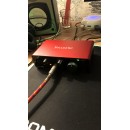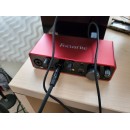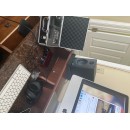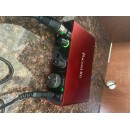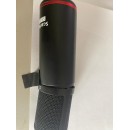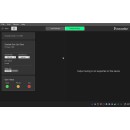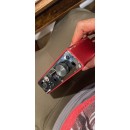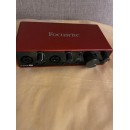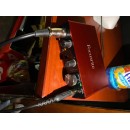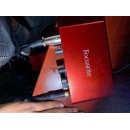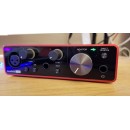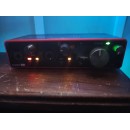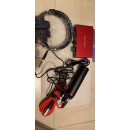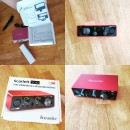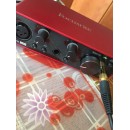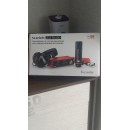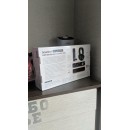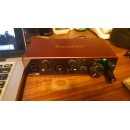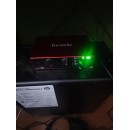Audient EVO 4 vs Focusrite Scarlett 2i2 (4th Gen): USB-C Audio Interface Showdown
The Focusrite Scarlett 2i2 (4th Gen) is known for its high-quality audio performance and user-friendly design. It features two upgraded Scarlett mic preamps with Air mode, which adds brightness and clarity to vocal recordings. The unit also includes high-headroom instrument inputs, allowing for clean recordings of guitars and other instruments. With a 24-bit/192kHz resolution, the Scarlett 2i2 ensures professional-grade sound quality. The 4th generation also introduces Auto Gain, Clip Safe, and a dynamic range improvement, making it easier to get the perfect recording levels. Its rugged metal chassis and compact size make it a durable and portable option for on-the-go recording.
On the other hand, the Audient EVO 4 is celebrated for its innovative and intuitive design. It offers two EVO preamps with Smartgain technology, which automatically sets the gain levels for you, simplifying the recording process for beginners and professionals alike. The EVO 4 also supports 24-bit/96kHz resolution, delivering excellent audio quality. One standout feature is its JFET instrument input, which provides a rich, warm sound when recording guitars. The interface includes a large volume knob and one-touch controls for easy navigation, along with a sleek, modern design. Additionally, the EVO 4 offers loopback functionality, making it ideal for podcasters and streamers who need to record computer audio along with their microphone inputs.
Both interfaces are USB-C compatible, ensuring fast and reliable connectivity with modern computers. The choice between them often comes down to specific needs: the Scarlett 2i2 is perfect for users who prioritize traditional high-quality preamps and a robust build, while the EVO 4 appeals to those who appreciate smart features and a user-friendly experience. Ultimately, both devices are excellent investments for those looking to enhance their recording capabilities.
Comprehensive Specifications, Advantages, and Disadvantages
| User Rating Based on Analysis of Reviews | |
|---|---|
|
Show More |
| Pros: | |
|---|---|
|
|
| Cons: | |
|---|---|
|
|
| Find Best Price | Find Best Price |
| Key Specs | |
|---|---|
| Channels of I/O | |
| Analog: 2 Inputs / 2 Outputs at 96 kHz |
Analog: 2 Inputs / 2 Outputs at 192 kHz |
| Maximum Sampling Rate | |
| 96 kHz / 24-Bit | 192 kHz / 24-Bit |
| Number of Microphone Inputs | |
| 2 Preamps | 2 |
| Analog Audio I/O | |
| 2x Combo XLR-1/4" TRS Balanced Mic/Line Input 1x 1/4" TS Unbalanced Hi-Z Input 2x 1/4" TRS Balanced Monitor Output 1x 1/4" TRS Unbalanced Headphone Output |
2x XLR 3-Pin Balanced Mic Input 2x 1/4" TRS Balanced/Unbalanced Line/Hi-Z Input (Front Panel) 2x 1/4" TRS Balanced Monitor Output 1x 1/4" TRS Headphone Output (Front Panel) |
| Host Connection | |
| 1x USB-C | 1x USB-C |
| OS Compatibility | |
| macOS 10.7.5 or Later Windows 7 or Later (32-/64-Bit) 6 or Later |
macOS Windows |
| Power Requirements | |
| USB Bus Power | USB Bus Power, USB Power Adapter (Not Included) |
The Focusrite Scarlett 2i2 boasts a higher maximum sampling rate of 192 kHz at 24-bit resolution, compared to the 96 kHz at 24-bit resolution of the Audient EVO 4. This gives the Scarlett 2i2 a slight edge in terms of potential audio fidelity and detail. Both interfaces offer 2 analog inputs and 2 outputs, but the Scarlett 2i2's inputs are distinctly categorized: it features 2 XLR 3-pin balanced mic inputs and 2 1/4" TRS balanced/unbalanced line/Hi-Z inputs on the front panel. In contrast, the Audient EVO 4 integrates 2 combo XLR-1/4" TRS balanced mic/line inputs and a single 1/4" TS unbalanced Hi-Z input.
For outputs, each interface provides 2x 1/4" TRS balanced monitor outputs and a 1/4" TRS headphone output. However, the Scarlett 2i2's headphone output is balanced, potentially offering better sound quality compared to the unbalanced headphone output on the EVO 4.
Both interfaces are equipped with a USB-C host connection, ensuring compatibility with modern computers. The Scarlett 2i2 is compatible with both macOS and Windows without specifying version limitations, while the EVO 4 supports macOS 10.7.5 or later and Windows 7 or later (32-/64-bit).
Power requirements for both devices are met through USB bus power, but the Scarlett 2i2 also mentions the option for a USB power adapter (not included), providing an alternative power source if needed.
In summary, the Focusrite Scarlett 2i2 offers higher maximum sampling rates and more defined input types, whereas the Audient EVO 4 provides versatile combo inputs and broader OS compatibility. Both interfaces are robust options for audio recording and production, catering to different priorities and workflows.
| General | |
|---|---|
| Channels of I/O | |
| Analog: 2 Inputs / 2 Outputs at 96 kHz |
Analog: 2 Inputs / 2 Outputs at 192 kHz |
| Maximum Sampling Rate | |
| 96 kHz / 24-Bit | 192 kHz / 24-Bit |
| Number of Microphone Inputs | |
| 2 Preamps | 2 |
| Input Level Adjustment | |
| 2x Automatic 1x Knob |
2x Knob |
| Expansion Slots | |
The Focusrite Scarlett 2i2 stands out with its higher maximum sampling rate of 192 kHz at 24-bit, compared to the Audient EVO 4's maximum sampling rate of 96 kHz at 24-bit. This higher sampling rate in the Scarlett 2i2 can provide superior audio fidelity, which may be crucial for users requiring the highest possible sound quality. Both interfaces feature 2 microphone inputs; however, Focusrite does not specify if these are preamps, whereas the Audient EVO 4 explicitly states the presence of 2 preamps.
In terms of input level adjustment, the Scarlett 2i2 uses 2 dedicated knobs for manual adjustment, offering precise control over input levels. The Audient EVO 4, on the other hand, incorporates 2 automatic level adjustment features along with 1 manual knob, providing a blend of convenience and control that may appeal to users who prefer a more streamlined setup process.
Neither the Focusrite Scarlett 2i2 nor the Audient EVO 4 includes built-in DSP or expansion slots, which means that users will need to rely on external software or hardware for additional processing capabilities and cannot expand their interface's functionality through expansion cards. The Focusrite Scarlett 2i2 also does not have a built-in microphone, a specification shared with the Audient EVO 4.
Overall, while both audio interfaces offer comparable basic functionality, the Scarlett 2i2's higher sampling rate and manual input level adjustments may appeal to users seeking more traditional and high-fidelity recording capabilities. In contrast, the Audient EVO 4's automatic level adjustments and integrated preamps provide a modern, user-friendly approach that might be more attractive to those looking for ease of use.
| Signal Processing | |
|---|---|
| Gain/Trim Range | |
| Mic/Line/Hi-Z Inputs: 58 dB |
Mic/Line Inputs: Up to +69 dB Hi-Z Inputs: 62 dB |
Examining the additional features, the Focusrite Scarlett 2i2 does not include specifications for a pad, high-pass filter, or specific solo/mute functionalities. On the other hand, the Audient EVO 4 clearly states the absence of a pad and high-pass filter. However, it compensates with a convenient mute feature available per input channel and for the master, enabling users to control their audio inputs and outputs more dynamically.
In summary, the Focusrite Scarlett 2i2 (4th Generation) excels with its higher gain/trim range, catering to users requiring more flexibility in their input levels, while the Audient EVO 4 provides essential mute functionality and a straightforward interface, despite its lower gain/trim range and absence of pad and high-pass filter features.
| Connectivity | |
|---|---|
| Analog Audio I/O | |
| 2x Combo XLR-1/4" TRS Balanced Mic/Line Input 1x 1/4" TS Unbalanced Hi-Z Input 2x 1/4" TRS Balanced Monitor Output 1x 1/4" TRS Unbalanced Headphone Output |
2x XLR 3-Pin Balanced Mic Input 2x 1/4" TRS Balanced/Unbalanced Line/Hi-Z Input (Front Panel) 2x 1/4" TRS Balanced Monitor Output 1x 1/4" TRS Headphone Output (Front Panel) |
| Phantom Power | |
| 48 V ± 4 V, Selectable On/Off (Selectable on Individual Inputs) | 48 V, Selectable On/Off |
| Digital Audio I/O | |
| Host Connection | |
| 1x USB-C | 1x USB-C |
| Host Connection Protocol | |
| USB 2.0 | USB 2.0 |
| USB (Non-Host) | |
| 1x USB-C (Power Input) | |
| Sync I/O | |
| Network I/O | |
| MIDI I/O | |
Focusrite Scarlett 2i2 USB-C Audio Interface (4th Generation)
Analog Audio I/O: The Focusrite Scarlett 2i2 features 2x XLR 3-Pin Balanced Mic Inputs and 2x 1/4" TRS Balanced/Unbalanced Line/Hi-Z Inputs on the front panel, which allows for versatile input options. Additionally, it includes 2x 1/4" TRS Balanced Monitor Outputs and a 1x 1/4" TRS Headphone Output on the front panel, designed for clear monitoring and headphone use.
Phantom Power: It provides 48 V phantom power, which is selectable on or off, suitable for powering condenser microphones.
Digital Audio I/O: The Scarlett 2i2 does not feature digital audio I/O options.
Host Connection: It connects to the host via 1x USB-C, following the USB 2.0 protocol. It also includes an additional USB-C port specifically for power input.
Additional I/O: The Scarlett 2i2 does not include Sync I/O, Network I/O, or MIDI I/O capabilities, and does not support wireless connections.
Audient EVO 4 USB-C Audio Interface
Analog Audio I/O: The Audient EVO 4 offers 2x Combo XLR-1/4" TRS Balanced Mic/Line Inputs, providing flexibility for using both microphone and line-level signals. It also has a dedicated 1x 1/4" TS Unbalanced Hi-Z Input for instruments. For monitoring, it includes 2x 1/4" TRS Balanced Monitor Outputs and a 1x 1/4" TRS Unbalanced Headphone Output.
Phantom Power: The EVO 4 provides 48 V phantom power with a ±4 V variance, which is selectable on or off individually for each input, offering greater control over power distribution to connected microphones.
Digital Audio I/O: Similar to the Scarlett 2i2, the EVO 4 does not feature digital audio I/O capabilities.
Host Connection: The EVO 4 also connects to the host via 1x USB-C using the USB 2.0 protocol. Unlike the Scarlett 2i2, it does not have an additional USB-C port for power input.
Additional I/O: The EVO 4 does not include Sync I/O, Network I/O, or MIDI I/O capabilities, and does not support wireless connections.
In summary, both the Focusrite Scarlett 2i2 (4th Generation) and the Audient EVO 4 offer robust, USB-C connected audio interface solutions with selectable 48 V phantom power and solid analog audio I/O configurations. The Scarlett 2i2 stands out with its dedicated USB-C power input and a higher number of balanced/unbalanced inputs, while the EVO 4 boasts individual phantom power control for each input and a dedicated Hi-Z input, catering to slightly different user preferences and needs.
| Performance | |
|---|---|
| Frequency Response | |
| Mic Inputs: 10 Hz to 40 kHz ±0.5 dB Line, Hi-Z Inputs: 10 Hz to 20 kHz ±0.5 dB A/D Converters: 10 Hz to fs/2 ±0.5 dB D/A Converters: 10 Hz to fs/2 ±0.5 dB Headphone Outputs: 10 Hz to fs/2 ±0.5 dB |
XLR Mic Inputs: 20 Hz to 20 kHz ±0.06 dB 1/4" Line Inputs: 20 Hz to 20 kHz 0.05 dB 1/4" Hi-Z Inputs: 20 Hz to 20 kHz 0.15 dB |
| Maximum Input Level | |
| Mic Inputs: +16 dBu Hi-Z Inputs: +10 dBu |
XLR Mic: 16 dBu 1/4" Line: 22 dBu 1/4" Hi-Z: 12 dBu |
| Maximum Output Level | |
| D/A Converters: +11 dBu |
1/4" Line: +16 dBu |
| Headphone Output Power | |
| 45 mW into 30 Ohms (Max) 52 mW into 60 Ohms (Max) 20 mW into 600 Ohms (Max) |
1/4": 32 mW into 33 Ohms 22 mW into 300 Ohms |
| Impedance | |
| Mic Inputs: > 3 Kilohms (Balanced) Line Inputs: > 10 Kilohms (Balanced) Hi-Z Inputs: 1 Megohm (Unbalanced) |
XLR Mic Inputs: 3 Kilohms 1/4" Line Inputs: 60 Kilohms 1/4" Hi-Z Inputs: 1 Megohms 1/4" Line Outputs: 100 Ohms 1/4" Headphone Outputs: < 50 Ohm |
| Dynamic Range | |
| AD/DA Converters: 113 dBA |
XLR Mic Inputs: 116 dBA 1/4" Line Inputs: 115.2 dBA 1/4" Hi-Z Inputs: 113 dBA 1/4" Line Outputs: 120 dB 1/4" Headphone: 112 dB (at 33 Ohms) 115 dB (at 300 Ohms) Digital A/D Converters: 120 dB Digital D/A Converters: 130 dBA |
| THD+N | |
| A/D Converters: < 0.001% (1 kHz, at -1 dBFS) D/A Converters: < 0.0015% (1 kHz, at -1 dBFS) Headphone Outputs: < 0.0015% (1 kHz, at -1 dBFS) Hi-Z Inputs: < 0.3% (1 kHz) Mic/Line Inputs: < 0.0015% (1 kHz) |
XLR Mic Inputs: -100 dB (at 8 dB Gain) 1/4" Line Inputs: -100 dB (at 8 dB Gain) 1/4" Hi-Z Inputs: -80 dB (at Minimum Gain) 1/4" Line Outputs: -109 dB 1/4" Headphone Outputs: -99 dB (at 33 Ohms) -108 dB (at 300 Ohms) Digital A/D Converters: -110 dB Digital D/A Converters: -115 dB |
| EIN | |
| Mic/Line Inputs: < -128 dB |
XLR Mic Inputs: -127 dBu A-Weighted |
Frequency Response: The Focusrite Scarlett 2i2 offers a frequency response from 20 Hz to 20 kHz across its XLR Mic, 1/4" Line, and 1/4" Hi-Z inputs with minimal deviation. The Audient EVO 4 extends this range, providing a frequency response from 10 Hz to 40 kHz for its mic inputs and 10 Hz to 20 kHz for line and Hi-Z inputs, with a slightly higher deviation of ±0.5 dB.
Maximum Input and Output Levels: The Scarlett 2i2 has a maximum input level of 16 dBu for XLR Mic, 22 dBu for 1/4" Line, and 12 dBu for 1/4" Hi-Z inputs, while its maximum output level on the 1/4" Line outputs is +16 dBu. The EVO 4 matches the maximum input level for mic inputs at +16 dBu but has a slightly lower maximum input level of +10 dBu for Hi-Z inputs. Its maximum output level for D/A converters is +11 dBu, which is lower than the Scarlett's output level.
Headphone Output Power: The headphone output power is significantly different between the two devices. The Scarlett 2i2 provides 32 mW into 33 Ohms and 22 mW into 300 Ohms, while the EVO 4 offers 45 mW into 30 Ohms, 52 mW into 60 Ohms, and 20 mW into 600 Ohms, making the EVO 4 more versatile for different headphone impedances.
Impedance: Both interfaces have similar impedance features, with the Scarlett 2i2 offering 3 Kilohms for XLR Mic Inputs, 60 Kilohms for 1/4" Line Inputs, and 1 Megohm for 1/4" Hi-Z Inputs. The Audient EVO 4’s mic inputs have over 3 Kilohms (balanced), line inputs over 10 Kilohms (balanced), and Hi-Z inputs at 1 Megohm (unbalanced).
Dynamic Range: The Scarlett 2i2 exhibits a higher dynamic range across its components, with 116 dBA for XLR Mic Inputs, 115.2 dBA for 1/4" Line Inputs, and 113 dBA for 1/4" Hi-Z Inputs. The Audient EVO 4 has a dynamic range of 113 dBA for its AD/DA converters.
THD+N: The Scarlett 2i2 shows very low THD+N values, with -100 dB for XLR Mic and 1/4" Line Inputs and -80 dB for 1/4" Hi-Z Inputs. The EVO 4 has exceptionally low THD+N values as well, with < 0.001% for A/D converters, < 0.0015% for D/A converters, and < 0.3% for Hi-Z inputs.
EIN: Both interfaces have impressive Equivalent Input Noise (EIN) values, with the Scarlett 2i2 having -127 dBu A-Weighted for XLR Mic Inputs and the EVO 4 having < -128 dB for Mic/Line Inputs.
In summary, the Focusrite Scarlett 2i2 excels in dynamic range and low THD+N values, while the Audient EVO 4 offers a broader frequency response and higher headphone output power. Both interfaces present excellent impedance and EIN values, making them strong contenders in the USB-C audio interface market.
| Digital Audio | |
|---|---|
| Sample Rates | |
| Up to 96 kHz | 44.1 / 48 / 88.2 / 96 / 176.4 / 192 kHz |
| Bit Depths | |
| Up to 24-Bit | 24-Bit |
| Sync Sources | |
| Internal | Internal |
The Focusrite Scarlett 2i2 supports a wide range of sample rates, including 44.1, 48, 88.2, 96, 176.4, and 192 kHz, providing greater flexibility for various recording needs. It operates at a 24-bit depth, ensuring high-resolution audio capture. The Scarlett 2i2 uses internal sync sources, making it suitable for standalone use without requiring external synchronization.
In comparison, the Audient EVO 4 offers sample rates up to 96 kHz, which is sufficient for most professional and home studio applications but does not reach as high as the Scarlett 2i2. Like the Scarlett, the EVO 4 also operates at up to 24-bit depth, providing high-quality audio resolution. Additionally, the EVO 4 features internal sync sources and offers low latency performance, with 5 ms at 44.1 kHz and 4.1 ms at 96 kHz, depending on the buffer size, which is crucial for real-time monitoring and recording.
Both interfaces are designed to be user-friendly and portable, with USB-C connectivity ensuring fast and reliable data transfer. However, the Focusrite Scarlett 2i2 stands out with its broader range of sample rates, making it a more versatile choice for users who require higher sample rate options. On the other hand, the Audient EVO 4's low latency performance and clear dBFS reference levels for inputs and outputs make it an excellent choice for those who prioritize minimal delay and precise audio level management.
| Audio Storage & Playback |
|---|
| Compatibility | |
|---|---|
| OS Compatibility | |
| macOS 10.7.5 or Later Windows 7 or Later (32-/64-Bit) 6 or Later |
macOS Windows |
The Focusrite Scarlett 2i2 (4th Generation) is compatible with both macOS and Windows operating systems. Additionally, it offers mobile app compatibility specifically for iPadOS. This makes it a versatile choice for users who switch between desktop and mobile setups, especially those who utilize iPads in their workflow.
In contrast, the Audient EVO 4 provides compatibility with a broader range of operating systems. It supports macOS 10.7.5 or later and Windows 7 or later (both 32-bit and 64-bit), as well as iOS 6 or later. This broader OS compatibility might be more appealing for users with older systems or those who need flexibility across various devices.
When it comes to hardware requirements, the Audient EVO 4 specifies that it needs a Mac with an Intel processor and a PC with at least a 1.6 GHz Intel Core 2 or AMD processor. It also requires 1 GB of RAM, an available USB 2.0 port, and an internet connection for registration and software/driver downloads. This detailed specification list ensures that users are well-informed about the necessary system capabilities to optimize the use of the EVO 4.
In summary, the Focusrite Scarlett 2i2 (4th Generation) stands out for its iPadOS compatibility, making it a good fit for mobile users. On the other hand, the Audient EVO 4 offers a broader range of OS compatibility and detailed hardware requirements, catering to a variety of system configurations and ensuring users have the necessary resources for optimal performance.
| Power | |
|---|---|
| Power Requirements | |
| USB Bus Power | USB Bus Power, USB Power Adapter (Not Included) |
The Focusrite Scarlett 2i2 (4th Generation) offers flexibility in its power options. It can be powered via USB bus power, which is convenient for mobile recording setups and eliminates the need for an external power source. Additionally, it supports a USB power adapter (not included) and an AC/DC power adapter with a requirement of 5 VDC at 900 mA. This versatility allows users to choose between relying on their computer's USB port or using an external power source, which can provide more stable power and potentially improve performance in demanding recording situations. The Scarlett 2i2 has a power consumption of 4.5 W, ensuring efficient energy use while maintaining high-quality audio performance.
In contrast, the Audient EVO 4 USB-C Audio Interface simplifies the power setup by solely relying on USB bus power. This makes the EVO 4 highly portable and easy to use, as it does not require any additional power adapters or sources. Users can simply connect it to their computer via USB-C, and it will draw the necessary power directly from the USB connection. This streamlined approach is particularly beneficial for those who need a quick and hassle-free setup, especially in mobile recording environments or for users with limited access to power outlets.
In summary, the Focusrite Scarlett 2i2 (4th Generation) provides greater flexibility in power options, accommodating both USB bus power and external power adapters, whereas the Audient EVO 4 focuses on simplicity and portability with its exclusive reliance on USB bus power. The choice between these two interfaces may come down to the user's specific needs for flexibility and convenience in their recording setup.
| Physical | |
|---|---|
| Dimensions | |
| 5.51 x 2.64 x 2.64" / 14 x 6.71 x 6.71 cm | 7.1 x 4.6 x 1.87" / 18 x 11.7 x 4.75 cm |
| Weight | |
| 12.7 oz / 360.0 g | 1.3 lb / 595.0 g |
In terms of portability, the Audient EVO 4 stands out due to its more compact size and lighter weight, making it more convenient for mobile recording setups or for those who frequently travel with their audio interface. On the other hand, the Focusrite Scarlett 2i2, while slightly bulkier, still remains highly portable and offers robust build quality that can be beneficial in various recording environments.
Both interfaces employ USB-C connectivity, ensuring fast data transfer and compatibility with modern devices. However, the choice between these two might come down to factors such as size preference, weight considerations, and specific feature sets offered by each interface.
| Packaging Info | |
|---|---|
| Package Weight | |
| 1.29 lb | 1.9 lb |
| Box Dimensions (LxWxH) | |
| 6.8 x 3.85 x 3.55" | 8.2 x 7 x 2.6" |
The Focusrite Scarlett 2i2 weighs 1.9 lb and has box dimensions of 8.2 x 7 x 2.6 inches. This indicates a slightly larger and heavier build compared to the Audient EVO 4, which has a package weight of 1.29 lb and more compact box dimensions of 6.8 x 3.85 x 3.55 inches. The Scarlett 2i2's additional weight and size might suggest a more robust construction, potentially offering a more substantial feel.
Both interfaces utilize USB-C connectivity, ensuring fast and reliable data transfer. However, the Scarlett 2i2's larger footprint may offer more physical space for additional or more spaciously arranged controls, which could be an advantage for users who prefer a more tactile interface.
In terms of packaging, the Scarlett 2i2's dimensions indicate a more extensive package, possibly containing more accessories or more protective packaging. The Audient EVO 4's compact dimensions and lighter weight make it more portable and easier to fit into tight spaces, which could be beneficial for mobile recording setups or users with limited desk space.
In summary, while the Focusrite Scarlett 2i2 offers a slightly larger and heavier package that might imply a more durable build and potentially more included accessories, the Audient EVO 4 provides a more compact and lightweight alternative that is easier to transport and manage in smaller spaces.
| Customer Images | |
|---|---|
| Videos | |
|---|---|
|
|
|
